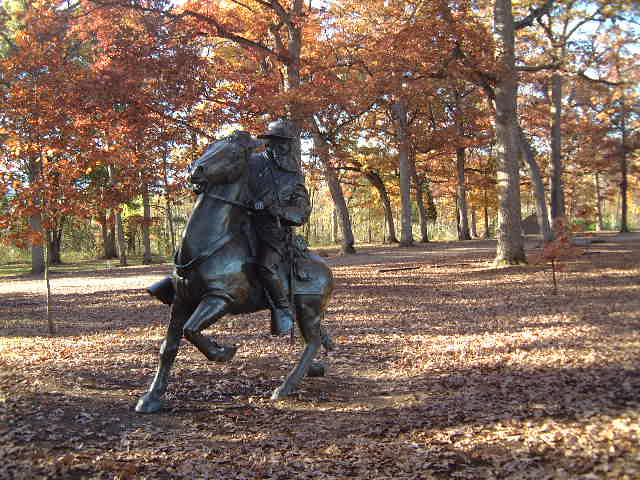 Click here for Longstreet's photo gallery
Click here for Longstreet's photo gallery
Longstreet is the most unique of all the equestrian statues. It was the last to be sculpted and does not appear on a platform.
Longstreet's statue is hidden away in a clearing of trees not to far from Lee's statue. His horse, named "Hero", is rearing back with the left front hoof in the air. According to the horse code the depicted rider had recieved a serious wound during the battle. Longstreet did suffer a nasty wound at the hands of friendly fire. The shot cut through his shoulder and throat. However, he did not receive this wound during the Battle of Gettysburg.
Is the code broken by Longstreet? Some believe so. This statue was sculpted by Gary Casteel, in 1998. People have criticized Casteel for not following "the code." Since this statue is not one of the original equestrians some guides still say that Gettysburg is the only place that follows the code. Personally, I feel a wound, especially one as severe as Longstreet's, should be honored no matter when it occured.
Born in Edgefield District, S.C. Graduated from West Point 1842. Served as Lieutenant with the 8th U.S. Infantry in the Mexican War and brevetted major for gallantry, Battle of Molino del Rey. Resigned commission as a major, U.S. Army, May 1861. Appointed brigadier general, Confederate States Army, June 1861. Promoted to Major General, CSA, October 1861. Promoted Lieutenant general, CSA, October 1862. Gen Robert E. Lee's second in command and ranking lieutenant general in the Army of Northern Virginia. Gallantly led troops in battles at First Manassas, the Peninsula, Second Manassas, Antietam, Fredericksburg, Gettysburg, Chickamauga and Knoxville. Wounded at Battle of the Wilderness, May 1864. Returned to duty during the Union siege of Petersburg, and present with Gen. Lee at surrender of army at Appomattox. Buried at Alta Vista Cemetery, Gainesville, GA.
"Ah! here is Longstreet, here's my 'Old War-Horse.'" - Gen. Robert E. Lee (September 17, 1862)
Soldiers of Gen. Longstreet's command held and protected the right wing of the army July 2-4, 1863. His First Corps attacked and dislodged Union forces at the Devil's Den, the Wheatfield and the Peach Orchard on July 2. As a portion of his infantry secured the Peach Orchard, Gen. Longstreet advanced on horseback with them. The following day, Gen. Longstreet was ordered by Gen. Robert E. Lee to coordinate an attack against the Union center on Cemetery Ridge. On July 3, "Longstreet's Assault" was repulsed with great loss after penetrating the enemy's battle lien on Cemetery Ridge. During the march back to Virginia, Gen. Longstreet and his First Corps played a prominent role in protecting the retreating army.
"By the soldiers he is invariably spoken of as 'the best fighter in the whole army.'" - Lt. Col. Arthur J. Fremantle, Her Majesty's Coldstream Guards (June 27, 1863)